Nursing Assignment: Salford Health Profile and Diabetes
VerifiedAdded on 2022/11/11
|15
|4153
|498
Report
AI Summary
This report provides a comprehensive analysis of the health profile of Salford, focusing on diabetes and related health complications. It examines the average life expectancy in Salford compared to the national average, highlighting the prevalence of overweight and obesity. The report delves into the health condition of diabetes, discussing its associated risk factors (modifiable and non-modifiable), and compares Salford's statistics with the national figures to identify contributing factors. It explores key determinants influencing the health experience of Salford residents, including obesity, coronary artery disease, and decreased life expectancy. Furthermore, the report discusses the application of the MECC (Making Every Contact Count) approach and identifies specific interventions that nurses can implement to promote health and wellbeing, including primary and secondary preventive interventions aimed at modifying behaviors and improving overall health outcomes for the population. The report also addresses the impact of smoking, alcohol consumption, and lack of physical activity on the health of the community, emphasizing the need for targeted interventions to address these modifiable risk factors. This assignment is contributed by a student to Desklib.

Running head: NURSING ASSIGNMENT
Nursing assignment
Name of the student
Name of the university
Author note
Nursing assignment
Name of the student
Name of the university
Author note
Paraphrase This Document
Need a fresh take? Get an instant paraphrase of this document with our AI Paraphraser
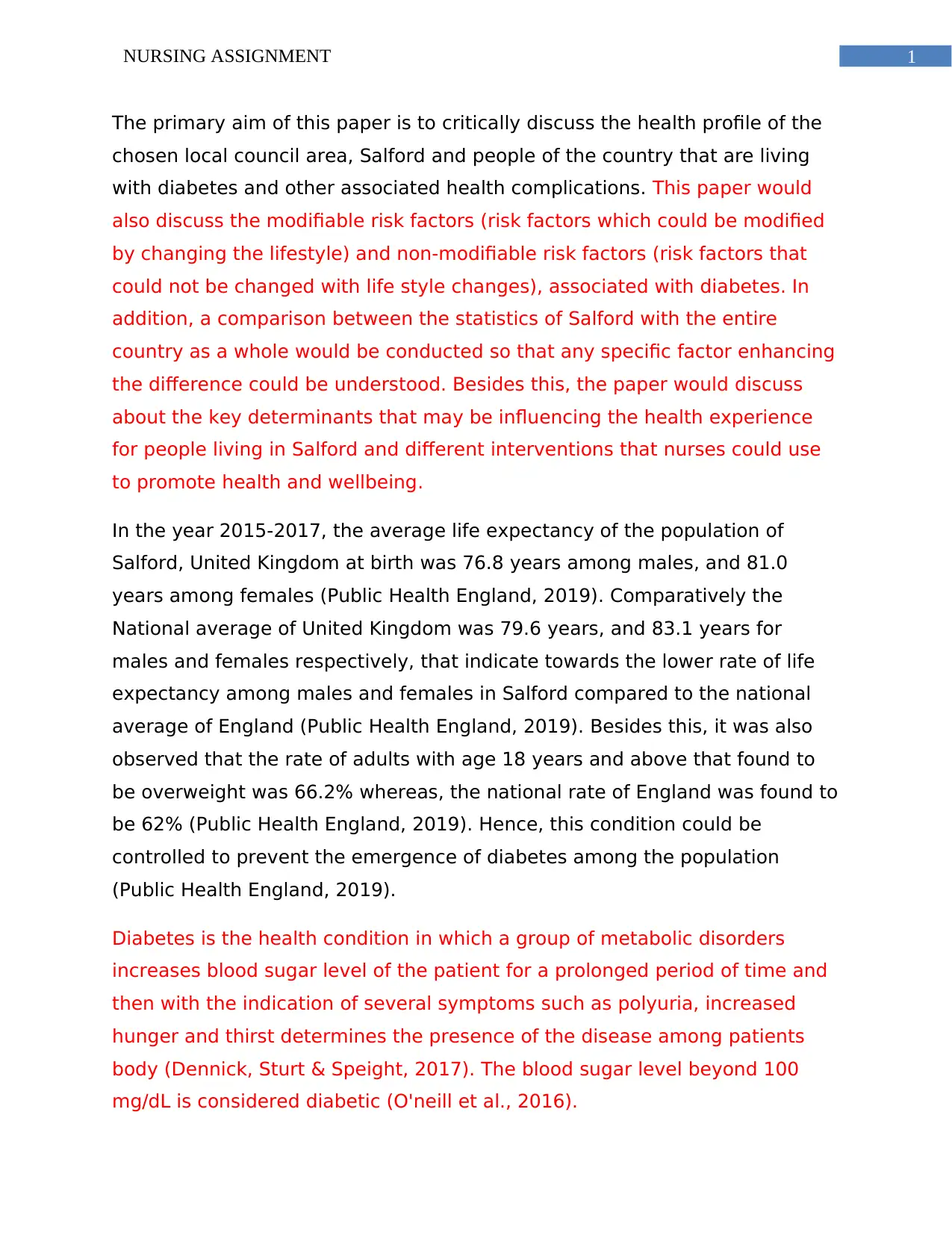
1NURSING ASSIGNMENT
The primary aim of this paper is to critically discuss the health profile of the
chosen local council area, Salford and people of the country that are living
with diabetes and other associated health complications. This paper would
also discuss the modifiable risk factors (risk factors which could be modified
by changing the lifestyle) and non-modifiable risk factors (risk factors that
could not be changed with life style changes), associated with diabetes. In
addition, a comparison between the statistics of Salford with the entire
country as a whole would be conducted so that any specific factor enhancing
the difference could be understood. Besides this, the paper would discuss
about the key determinants that may be influencing the health experience
for people living in Salford and different interventions that nurses could use
to promote health and wellbeing.
In the year 2015-2017, the average life expectancy of the population of
Salford, United Kingdom at birth was 76.8 years among males, and 81.0
years among females (Public Health England, 2019). Comparatively the
National average of United Kingdom was 79.6 years, and 83.1 years for
males and females respectively, that indicate towards the lower rate of life
expectancy among males and females in Salford compared to the national
average of England (Public Health England, 2019). Besides this, it was also
observed that the rate of adults with age 18 years and above that found to
be overweight was 66.2% whereas, the national rate of England was found to
be 62% (Public Health England, 2019). Hence, this condition could be
controlled to prevent the emergence of diabetes among the population
(Public Health England, 2019).
Diabetes is the health condition in which a group of metabolic disorders
increases blood sugar level of the patient for a prolonged period of time and
then with the indication of several symptoms such as polyuria, increased
hunger and thirst determines the presence of the disease among patients
body (Dennick, Sturt & Speight, 2017). The blood sugar level beyond 100
mg/dL is considered diabetic (O'neill et al., 2016).
The primary aim of this paper is to critically discuss the health profile of the
chosen local council area, Salford and people of the country that are living
with diabetes and other associated health complications. This paper would
also discuss the modifiable risk factors (risk factors which could be modified
by changing the lifestyle) and non-modifiable risk factors (risk factors that
could not be changed with life style changes), associated with diabetes. In
addition, a comparison between the statistics of Salford with the entire
country as a whole would be conducted so that any specific factor enhancing
the difference could be understood. Besides this, the paper would discuss
about the key determinants that may be influencing the health experience
for people living in Salford and different interventions that nurses could use
to promote health and wellbeing.
In the year 2015-2017, the average life expectancy of the population of
Salford, United Kingdom at birth was 76.8 years among males, and 81.0
years among females (Public Health England, 2019). Comparatively the
National average of United Kingdom was 79.6 years, and 83.1 years for
males and females respectively, that indicate towards the lower rate of life
expectancy among males and females in Salford compared to the national
average of England (Public Health England, 2019). Besides this, it was also
observed that the rate of adults with age 18 years and above that found to
be overweight was 66.2% whereas, the national rate of England was found to
be 62% (Public Health England, 2019). Hence, this condition could be
controlled to prevent the emergence of diabetes among the population
(Public Health England, 2019).
Diabetes is the health condition in which a group of metabolic disorders
increases blood sugar level of the patient for a prolonged period of time and
then with the indication of several symptoms such as polyuria, increased
hunger and thirst determines the presence of the disease among patients
body (Dennick, Sturt & Speight, 2017). The blood sugar level beyond 100
mg/dL is considered diabetic (O'neill et al., 2016).
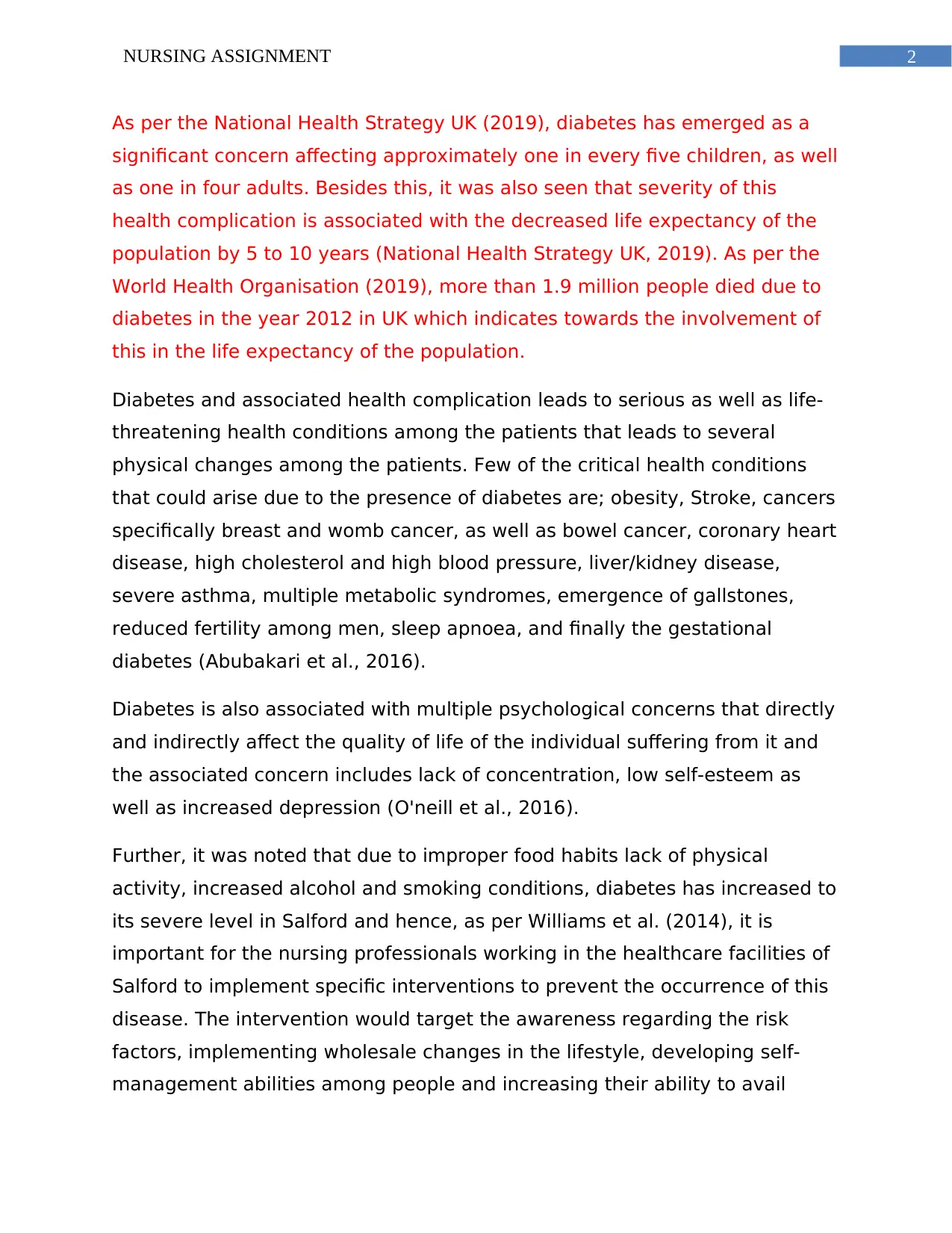
2NURSING ASSIGNMENT
As per the National Health Strategy UK (2019), diabetes has emerged as a
significant concern affecting approximately one in every five children, as well
as one in four adults. Besides this, it was also seen that severity of this
health complication is associated with the decreased life expectancy of the
population by 5 to 10 years (National Health Strategy UK, 2019). As per the
World Health Organisation (2019), more than 1.9 million people died due to
diabetes in the year 2012 in UK which indicates towards the involvement of
this in the life expectancy of the population.
Diabetes and associated health complication leads to serious as well as life-
threatening health conditions among the patients that leads to several
physical changes among the patients. Few of the critical health conditions
that could arise due to the presence of diabetes are; obesity, Stroke, cancers
specifically breast and womb cancer, as well as bowel cancer, coronary heart
disease, high cholesterol and high blood pressure, liver/kidney disease,
severe asthma, multiple metabolic syndromes, emergence of gallstones,
reduced fertility among men, sleep apnoea, and finally the gestational
diabetes (Abubakari et al., 2016).
Diabetes is also associated with multiple psychological concerns that directly
and indirectly affect the quality of life of the individual suffering from it and
the associated concern includes lack of concentration, low self-esteem as
well as increased depression (O'neill et al., 2016).
Further, it was noted that due to improper food habits lack of physical
activity, increased alcohol and smoking conditions, diabetes has increased to
its severe level in Salford and hence, as per Williams et al. (2014), it is
important for the nursing professionals working in the healthcare facilities of
Salford to implement specific interventions to prevent the occurrence of this
disease. The intervention would target the awareness regarding the risk
factors, implementing wholesale changes in the lifestyle, developing self-
management abilities among people and increasing their ability to avail
As per the National Health Strategy UK (2019), diabetes has emerged as a
significant concern affecting approximately one in every five children, as well
as one in four adults. Besides this, it was also seen that severity of this
health complication is associated with the decreased life expectancy of the
population by 5 to 10 years (National Health Strategy UK, 2019). As per the
World Health Organisation (2019), more than 1.9 million people died due to
diabetes in the year 2012 in UK which indicates towards the involvement of
this in the life expectancy of the population.
Diabetes and associated health complication leads to serious as well as life-
threatening health conditions among the patients that leads to several
physical changes among the patients. Few of the critical health conditions
that could arise due to the presence of diabetes are; obesity, Stroke, cancers
specifically breast and womb cancer, as well as bowel cancer, coronary heart
disease, high cholesterol and high blood pressure, liver/kidney disease,
severe asthma, multiple metabolic syndromes, emergence of gallstones,
reduced fertility among men, sleep apnoea, and finally the gestational
diabetes (Abubakari et al., 2016).
Diabetes is also associated with multiple psychological concerns that directly
and indirectly affect the quality of life of the individual suffering from it and
the associated concern includes lack of concentration, low self-esteem as
well as increased depression (O'neill et al., 2016).
Further, it was noted that due to improper food habits lack of physical
activity, increased alcohol and smoking conditions, diabetes has increased to
its severe level in Salford and hence, as per Williams et al. (2014), it is
important for the nursing professionals working in the healthcare facilities of
Salford to implement specific interventions to prevent the occurrence of this
disease. The intervention would target the awareness regarding the risk
factors, implementing wholesale changes in the lifestyle, developing self-
management abilities among people and increasing their ability to avail
⊘ This is a preview!⊘
Do you want full access?
Subscribe today to unlock all pages.

Trusted by 1+ million students worldwide
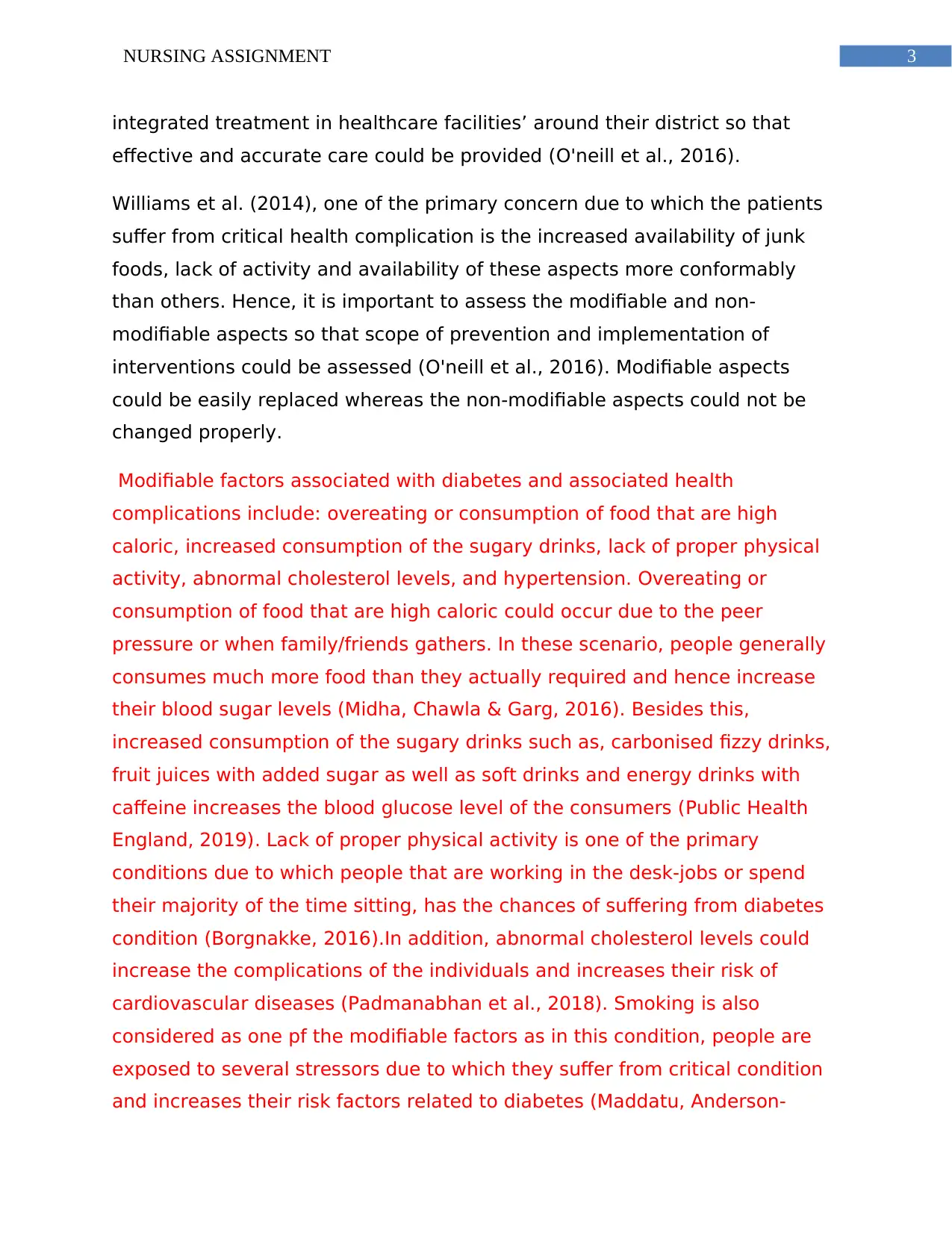
3NURSING ASSIGNMENT
integrated treatment in healthcare facilities’ around their district so that
effective and accurate care could be provided (O'neill et al., 2016).
Williams et al. (2014), one of the primary concern due to which the patients
suffer from critical health complication is the increased availability of junk
foods, lack of activity and availability of these aspects more conformably
than others. Hence, it is important to assess the modifiable and non-
modifiable aspects so that scope of prevention and implementation of
interventions could be assessed (O'neill et al., 2016). Modifiable aspects
could be easily replaced whereas the non-modifiable aspects could not be
changed properly.
Modifiable factors associated with diabetes and associated health
complications include: overeating or consumption of food that are high
caloric, increased consumption of the sugary drinks, lack of proper physical
activity, abnormal cholesterol levels, and hypertension. Overeating or
consumption of food that are high caloric could occur due to the peer
pressure or when family/friends gathers. In these scenario, people generally
consumes much more food than they actually required and hence increase
their blood sugar levels (Midha, Chawla & Garg, 2016). Besides this,
increased consumption of the sugary drinks such as, carbonised fizzy drinks,
fruit juices with added sugar as well as soft drinks and energy drinks with
caffeine increases the blood glucose level of the consumers (Public Health
England, 2019). Lack of proper physical activity is one of the primary
conditions due to which people that are working in the desk-jobs or spend
their majority of the time sitting, has the chances of suffering from diabetes
condition (Borgnakke, 2016).In addition, abnormal cholesterol levels could
increase the complications of the individuals and increases their risk of
cardiovascular diseases (Padmanabhan et al., 2018). Smoking is also
considered as one pf the modifiable factors as in this condition, people are
exposed to several stressors due to which they suffer from critical condition
and increases their risk factors related to diabetes (Maddatu, Anderson-
integrated treatment in healthcare facilities’ around their district so that
effective and accurate care could be provided (O'neill et al., 2016).
Williams et al. (2014), one of the primary concern due to which the patients
suffer from critical health complication is the increased availability of junk
foods, lack of activity and availability of these aspects more conformably
than others. Hence, it is important to assess the modifiable and non-
modifiable aspects so that scope of prevention and implementation of
interventions could be assessed (O'neill et al., 2016). Modifiable aspects
could be easily replaced whereas the non-modifiable aspects could not be
changed properly.
Modifiable factors associated with diabetes and associated health
complications include: overeating or consumption of food that are high
caloric, increased consumption of the sugary drinks, lack of proper physical
activity, abnormal cholesterol levels, and hypertension. Overeating or
consumption of food that are high caloric could occur due to the peer
pressure or when family/friends gathers. In these scenario, people generally
consumes much more food than they actually required and hence increase
their blood sugar levels (Midha, Chawla & Garg, 2016). Besides this,
increased consumption of the sugary drinks such as, carbonised fizzy drinks,
fruit juices with added sugar as well as soft drinks and energy drinks with
caffeine increases the blood glucose level of the consumers (Public Health
England, 2019). Lack of proper physical activity is one of the primary
conditions due to which people that are working in the desk-jobs or spend
their majority of the time sitting, has the chances of suffering from diabetes
condition (Borgnakke, 2016).In addition, abnormal cholesterol levels could
increase the complications of the individuals and increases their risk of
cardiovascular diseases (Padmanabhan et al., 2018). Smoking is also
considered as one pf the modifiable factors as in this condition, people are
exposed to several stressors due to which they suffer from critical condition
and increases their risk factors related to diabetes (Maddatu, Anderson-
Paraphrase This Document
Need a fresh take? Get an instant paraphrase of this document with our AI Paraphraser
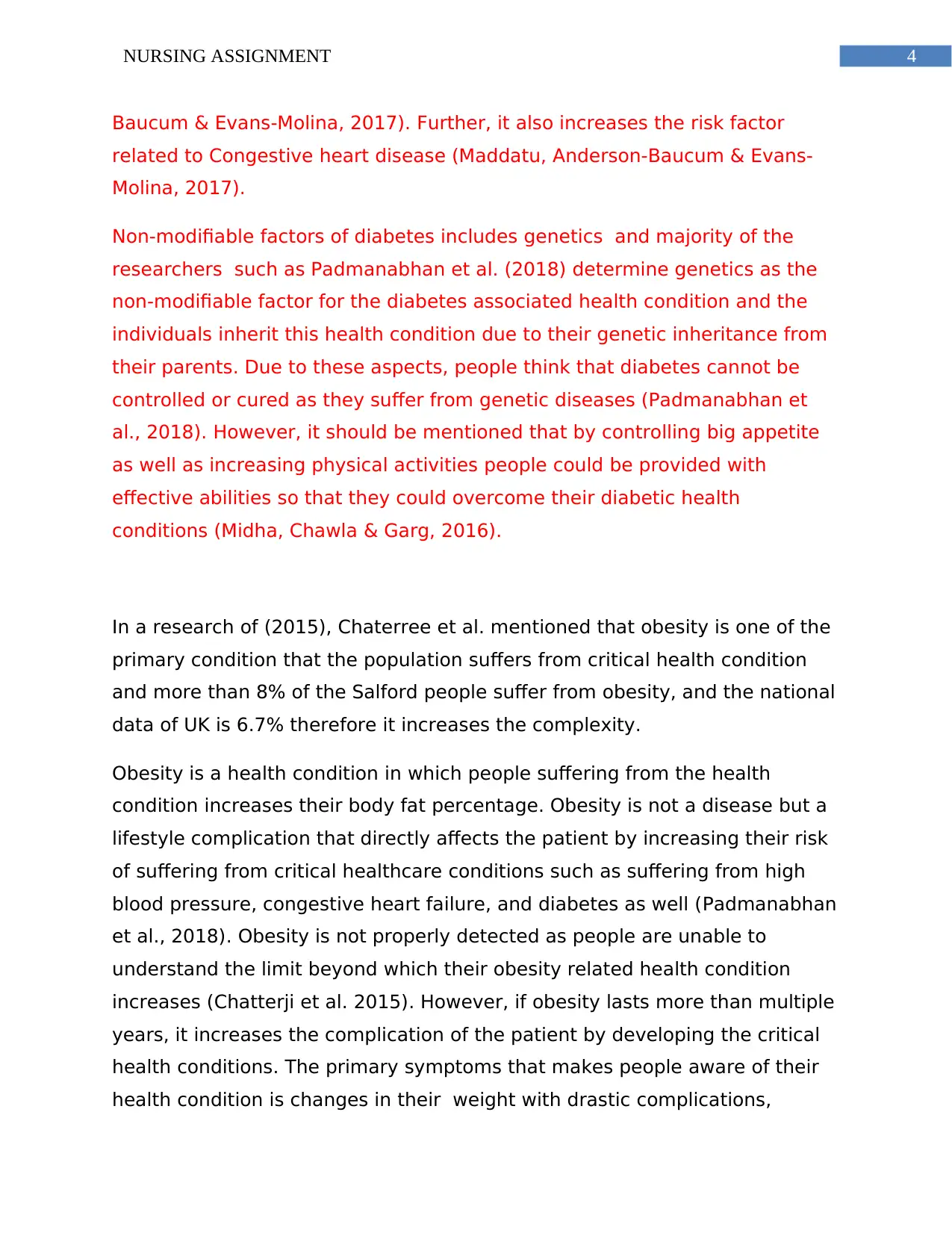
4NURSING ASSIGNMENT
Baucum & Evans-Molina, 2017). Further, it also increases the risk factor
related to Congestive heart disease (Maddatu, Anderson-Baucum & Evans-
Molina, 2017).
Non-modifiable factors of diabetes includes genetics and majority of the
researchers such as Padmanabhan et al. (2018) determine genetics as the
non-modifiable factor for the diabetes associated health condition and the
individuals inherit this health condition due to their genetic inheritance from
their parents. Due to these aspects, people think that diabetes cannot be
controlled or cured as they suffer from genetic diseases (Padmanabhan et
al., 2018). However, it should be mentioned that by controlling big appetite
as well as increasing physical activities people could be provided with
effective abilities so that they could overcome their diabetic health
conditions (Midha, Chawla & Garg, 2016).
In a research of (2015), Chaterree et al. mentioned that obesity is one of the
primary condition that the population suffers from critical health condition
and more than 8% of the Salford people suffer from obesity, and the national
data of UK is 6.7% therefore it increases the complexity.
Obesity is a health condition in which people suffering from the health
condition increases their body fat percentage. Obesity is not a disease but a
lifestyle complication that directly affects the patient by increasing their risk
of suffering from critical healthcare conditions such as suffering from high
blood pressure, congestive heart failure, and diabetes as well (Padmanabhan
et al., 2018). Obesity is not properly detected as people are unable to
understand the limit beyond which their obesity related health condition
increases (Chatterji et al. 2015). However, if obesity lasts more than multiple
years, it increases the complication of the patient by developing the critical
health conditions. The primary symptoms that makes people aware of their
health condition is changes in their weight with drastic complications,
Baucum & Evans-Molina, 2017). Further, it also increases the risk factor
related to Congestive heart disease (Maddatu, Anderson-Baucum & Evans-
Molina, 2017).
Non-modifiable factors of diabetes includes genetics and majority of the
researchers such as Padmanabhan et al. (2018) determine genetics as the
non-modifiable factor for the diabetes associated health condition and the
individuals inherit this health condition due to their genetic inheritance from
their parents. Due to these aspects, people think that diabetes cannot be
controlled or cured as they suffer from genetic diseases (Padmanabhan et
al., 2018). However, it should be mentioned that by controlling big appetite
as well as increasing physical activities people could be provided with
effective abilities so that they could overcome their diabetic health
conditions (Midha, Chawla & Garg, 2016).
In a research of (2015), Chaterree et al. mentioned that obesity is one of the
primary condition that the population suffers from critical health condition
and more than 8% of the Salford people suffer from obesity, and the national
data of UK is 6.7% therefore it increases the complexity.
Obesity is a health condition in which people suffering from the health
condition increases their body fat percentage. Obesity is not a disease but a
lifestyle complication that directly affects the patient by increasing their risk
of suffering from critical healthcare conditions such as suffering from high
blood pressure, congestive heart failure, and diabetes as well (Padmanabhan
et al., 2018). Obesity is not properly detected as people are unable to
understand the limit beyond which their obesity related health condition
increases (Chatterji et al. 2015). However, if obesity lasts more than multiple
years, it increases the complication of the patient by developing the critical
health conditions. The primary symptoms that makes people aware of their
health condition is changes in their weight with drastic complications,
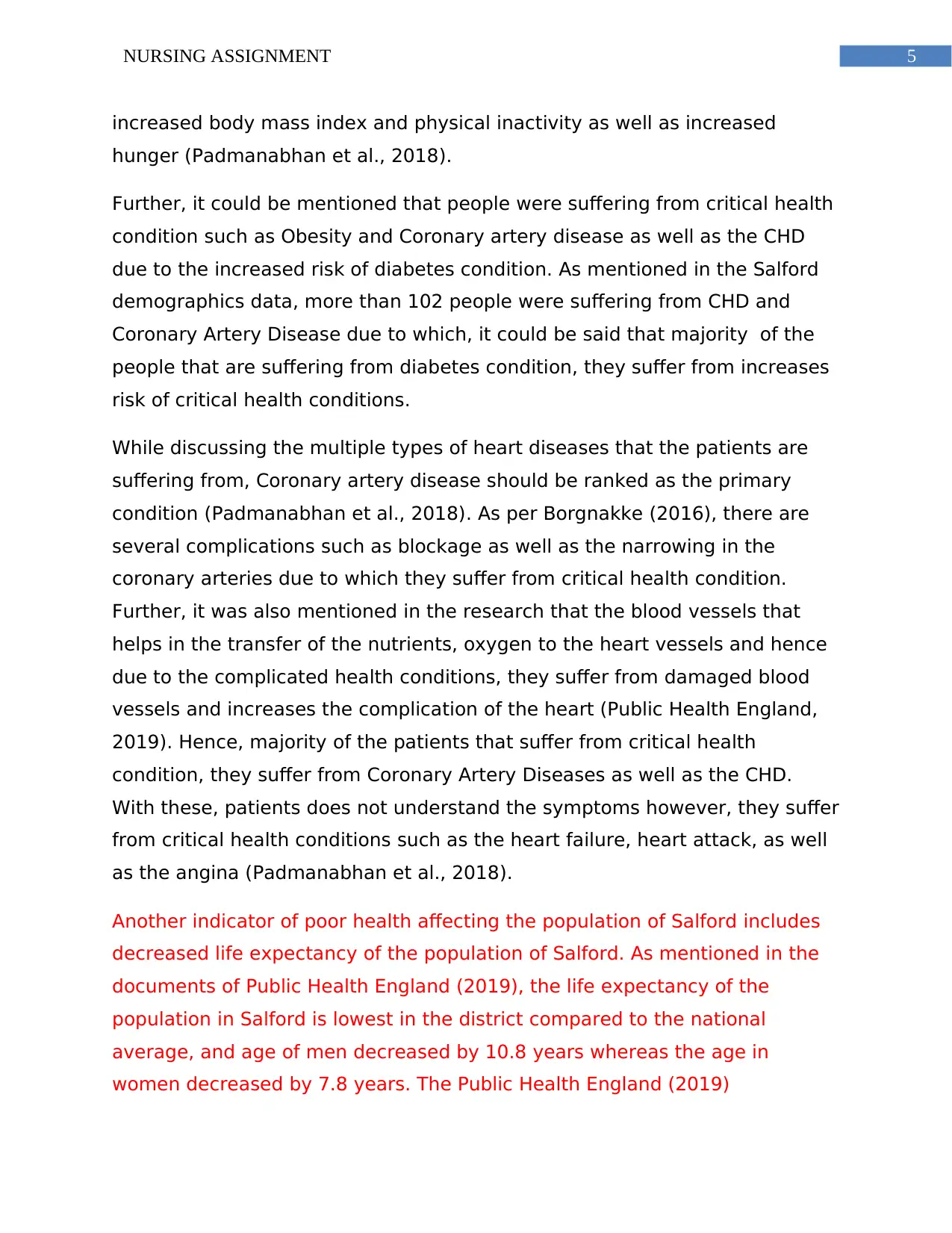
5NURSING ASSIGNMENT
increased body mass index and physical inactivity as well as increased
hunger (Padmanabhan et al., 2018).
Further, it could be mentioned that people were suffering from critical health
condition such as Obesity and Coronary artery disease as well as the CHD
due to the increased risk of diabetes condition. As mentioned in the Salford
demographics data, more than 102 people were suffering from CHD and
Coronary Artery Disease due to which, it could be said that majority of the
people that are suffering from diabetes condition, they suffer from increases
risk of critical health conditions.
While discussing the multiple types of heart diseases that the patients are
suffering from, Coronary artery disease should be ranked as the primary
condition (Padmanabhan et al., 2018). As per Borgnakke (2016), there are
several complications such as blockage as well as the narrowing in the
coronary arteries due to which they suffer from critical health condition.
Further, it was also mentioned in the research that the blood vessels that
helps in the transfer of the nutrients, oxygen to the heart vessels and hence
due to the complicated health conditions, they suffer from damaged blood
vessels and increases the complication of the heart (Public Health England,
2019). Hence, majority of the patients that suffer from critical health
condition, they suffer from Coronary Artery Diseases as well as the CHD.
With these, patients does not understand the symptoms however, they suffer
from critical health conditions such as the heart failure, heart attack, as well
as the angina (Padmanabhan et al., 2018).
Another indicator of poor health affecting the population of Salford includes
decreased life expectancy of the population of Salford. As mentioned in the
documents of Public Health England (2019), the life expectancy of the
population in Salford is lowest in the district compared to the national
average, and age of men decreased by 10.8 years whereas the age in
women decreased by 7.8 years. The Public Health England (2019)
increased body mass index and physical inactivity as well as increased
hunger (Padmanabhan et al., 2018).
Further, it could be mentioned that people were suffering from critical health
condition such as Obesity and Coronary artery disease as well as the CHD
due to the increased risk of diabetes condition. As mentioned in the Salford
demographics data, more than 102 people were suffering from CHD and
Coronary Artery Disease due to which, it could be said that majority of the
people that are suffering from diabetes condition, they suffer from increases
risk of critical health conditions.
While discussing the multiple types of heart diseases that the patients are
suffering from, Coronary artery disease should be ranked as the primary
condition (Padmanabhan et al., 2018). As per Borgnakke (2016), there are
several complications such as blockage as well as the narrowing in the
coronary arteries due to which they suffer from critical health condition.
Further, it was also mentioned in the research that the blood vessels that
helps in the transfer of the nutrients, oxygen to the heart vessels and hence
due to the complicated health conditions, they suffer from damaged blood
vessels and increases the complication of the heart (Public Health England,
2019). Hence, majority of the patients that suffer from critical health
condition, they suffer from Coronary Artery Diseases as well as the CHD.
With these, patients does not understand the symptoms however, they suffer
from critical health conditions such as the heart failure, heart attack, as well
as the angina (Padmanabhan et al., 2018).
Another indicator of poor health affecting the population of Salford includes
decreased life expectancy of the population of Salford. As mentioned in the
documents of Public Health England (2019), the life expectancy of the
population in Salford is lowest in the district compared to the national
average, and age of men decreased by 10.8 years whereas the age in
women decreased by 7.8 years. The Public Health England (2019)
⊘ This is a preview!⊘
Do you want full access?
Subscribe today to unlock all pages.

Trusted by 1+ million students worldwide
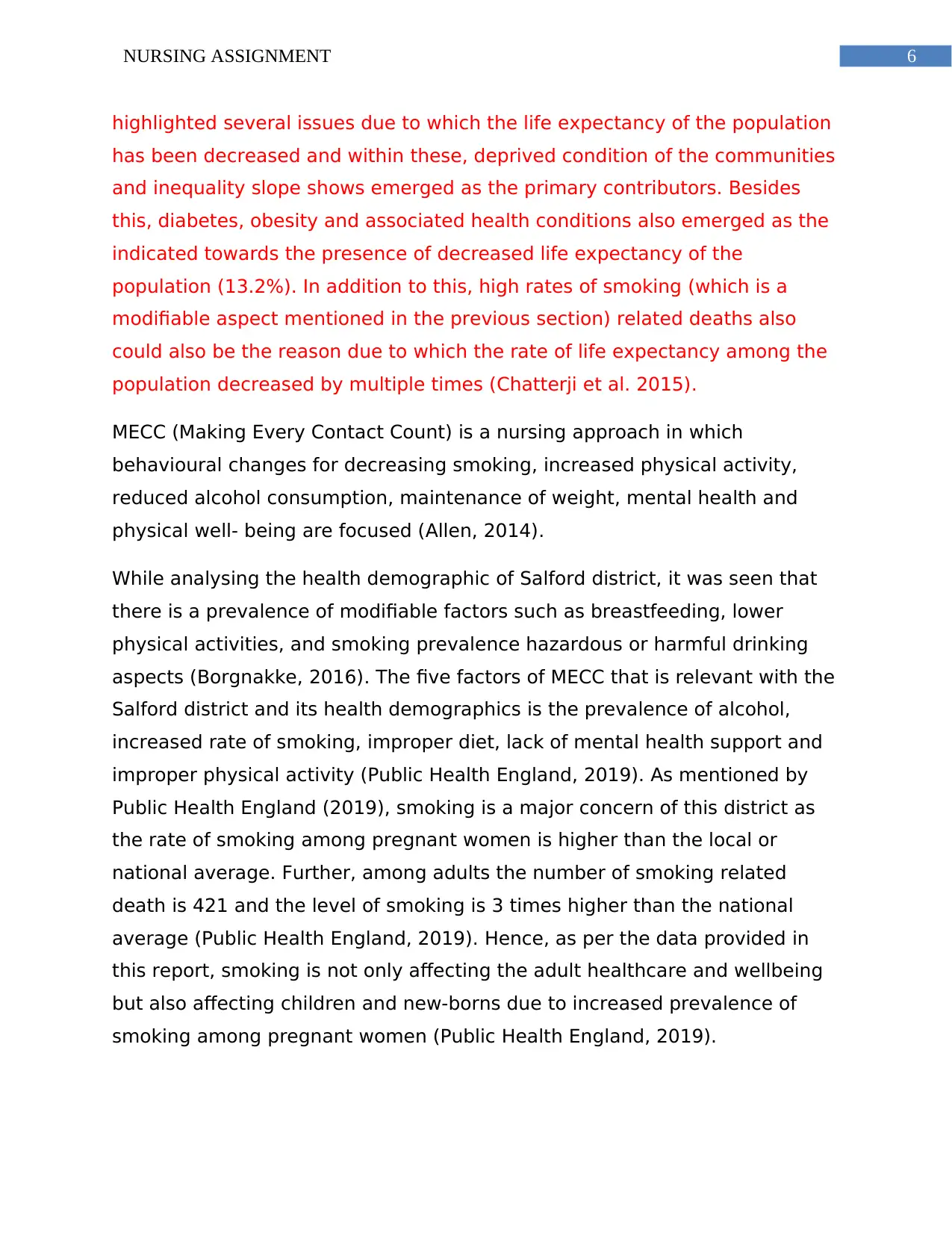
6NURSING ASSIGNMENT
highlighted several issues due to which the life expectancy of the population
has been decreased and within these, deprived condition of the communities
and inequality slope shows emerged as the primary contributors. Besides
this, diabetes, obesity and associated health conditions also emerged as the
indicated towards the presence of decreased life expectancy of the
population (13.2%). In addition to this, high rates of smoking (which is a
modifiable aspect mentioned in the previous section) related deaths also
could also be the reason due to which the rate of life expectancy among the
population decreased by multiple times (Chatterji et al. 2015).
MECC (Making Every Contact Count) is a nursing approach in which
behavioural changes for decreasing smoking, increased physical activity,
reduced alcohol consumption, maintenance of weight, mental health and
physical well- being are focused (Allen, 2014).
While analysing the health demographic of Salford district, it was seen that
there is a prevalence of modifiable factors such as breastfeeding, lower
physical activities, and smoking prevalence hazardous or harmful drinking
aspects (Borgnakke, 2016). The five factors of MECC that is relevant with the
Salford district and its health demographics is the prevalence of alcohol,
increased rate of smoking, improper diet, lack of mental health support and
improper physical activity (Public Health England, 2019). As mentioned by
Public Health England (2019), smoking is a major concern of this district as
the rate of smoking among pregnant women is higher than the local or
national average. Further, among adults the number of smoking related
death is 421 and the level of smoking is 3 times higher than the national
average (Public Health England, 2019). Hence, as per the data provided in
this report, smoking is not only affecting the adult healthcare and wellbeing
but also affecting children and new-borns due to increased prevalence of
smoking among pregnant women (Public Health England, 2019).
highlighted several issues due to which the life expectancy of the population
has been decreased and within these, deprived condition of the communities
and inequality slope shows emerged as the primary contributors. Besides
this, diabetes, obesity and associated health conditions also emerged as the
indicated towards the presence of decreased life expectancy of the
population (13.2%). In addition to this, high rates of smoking (which is a
modifiable aspect mentioned in the previous section) related deaths also
could also be the reason due to which the rate of life expectancy among the
population decreased by multiple times (Chatterji et al. 2015).
MECC (Making Every Contact Count) is a nursing approach in which
behavioural changes for decreasing smoking, increased physical activity,
reduced alcohol consumption, maintenance of weight, mental health and
physical well- being are focused (Allen, 2014).
While analysing the health demographic of Salford district, it was seen that
there is a prevalence of modifiable factors such as breastfeeding, lower
physical activities, and smoking prevalence hazardous or harmful drinking
aspects (Borgnakke, 2016). The five factors of MECC that is relevant with the
Salford district and its health demographics is the prevalence of alcohol,
increased rate of smoking, improper diet, lack of mental health support and
improper physical activity (Public Health England, 2019). As mentioned by
Public Health England (2019), smoking is a major concern of this district as
the rate of smoking among pregnant women is higher than the local or
national average. Further, among adults the number of smoking related
death is 421 and the level of smoking is 3 times higher than the national
average (Public Health England, 2019). Hence, as per the data provided in
this report, smoking is not only affecting the adult healthcare and wellbeing
but also affecting children and new-borns due to increased prevalence of
smoking among pregnant women (Public Health England, 2019).
Paraphrase This Document
Need a fresh take? Get an instant paraphrase of this document with our AI Paraphraser
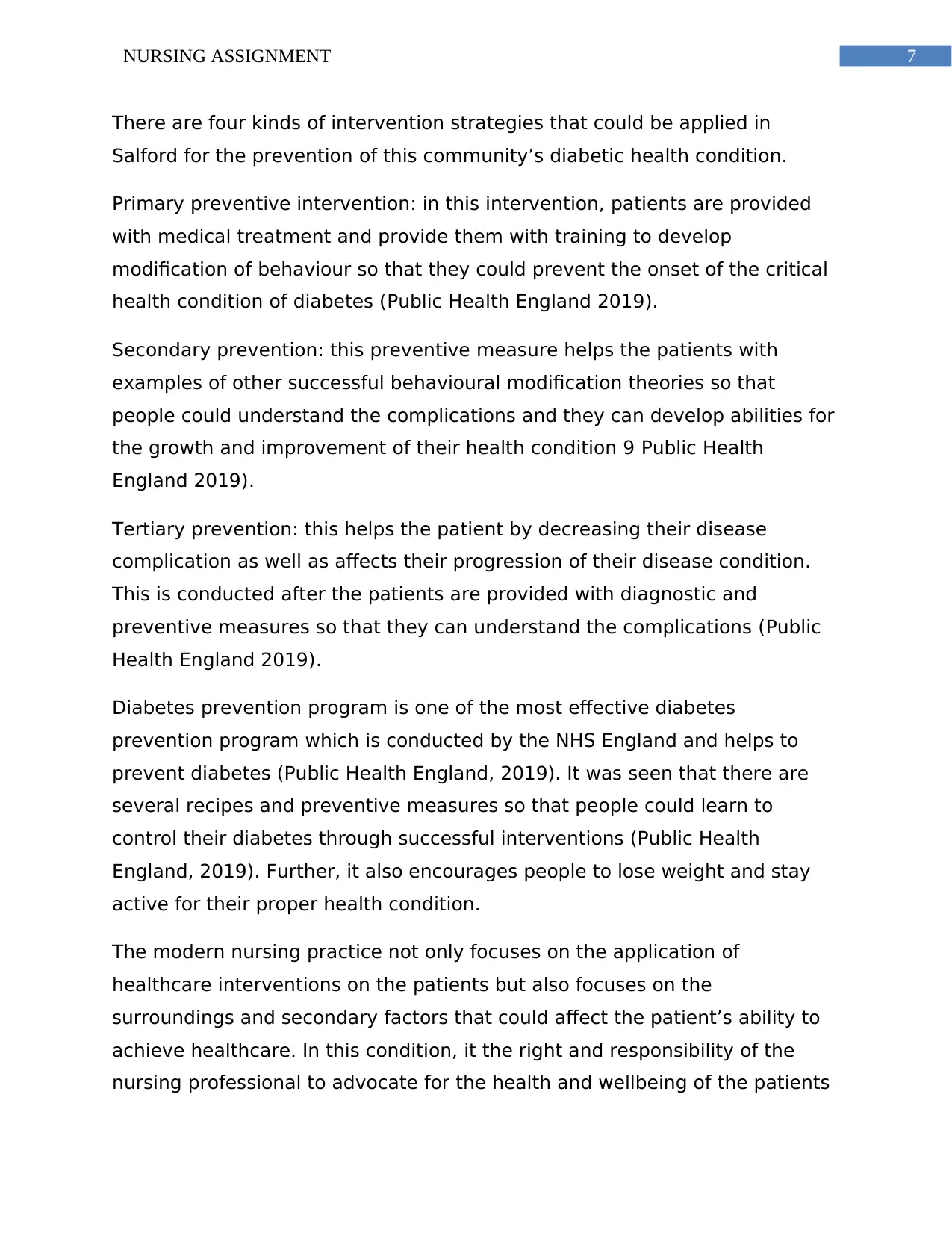
7NURSING ASSIGNMENT
There are four kinds of intervention strategies that could be applied in
Salford for the prevention of this community’s diabetic health condition.
Primary preventive intervention: in this intervention, patients are provided
with medical treatment and provide them with training to develop
modification of behaviour so that they could prevent the onset of the critical
health condition of diabetes (Public Health England 2019).
Secondary prevention: this preventive measure helps the patients with
examples of other successful behavioural modification theories so that
people could understand the complications and they can develop abilities for
the growth and improvement of their health condition 9 Public Health
England 2019).
Tertiary prevention: this helps the patient by decreasing their disease
complication as well as affects their progression of their disease condition.
This is conducted after the patients are provided with diagnostic and
preventive measures so that they can understand the complications (Public
Health England 2019).
Diabetes prevention program is one of the most effective diabetes
prevention program which is conducted by the NHS England and helps to
prevent diabetes (Public Health England, 2019). It was seen that there are
several recipes and preventive measures so that people could learn to
control their diabetes through successful interventions (Public Health
England, 2019). Further, it also encourages people to lose weight and stay
active for their proper health condition.
The modern nursing practice not only focuses on the application of
healthcare interventions on the patients but also focuses on the
surroundings and secondary factors that could affect the patient’s ability to
achieve healthcare. In this condition, it the right and responsibility of the
nursing professional to advocate for the health and wellbeing of the patients
There are four kinds of intervention strategies that could be applied in
Salford for the prevention of this community’s diabetic health condition.
Primary preventive intervention: in this intervention, patients are provided
with medical treatment and provide them with training to develop
modification of behaviour so that they could prevent the onset of the critical
health condition of diabetes (Public Health England 2019).
Secondary prevention: this preventive measure helps the patients with
examples of other successful behavioural modification theories so that
people could understand the complications and they can develop abilities for
the growth and improvement of their health condition 9 Public Health
England 2019).
Tertiary prevention: this helps the patient by decreasing their disease
complication as well as affects their progression of their disease condition.
This is conducted after the patients are provided with diagnostic and
preventive measures so that they can understand the complications (Public
Health England 2019).
Diabetes prevention program is one of the most effective diabetes
prevention program which is conducted by the NHS England and helps to
prevent diabetes (Public Health England, 2019). It was seen that there are
several recipes and preventive measures so that people could learn to
control their diabetes through successful interventions (Public Health
England, 2019). Further, it also encourages people to lose weight and stay
active for their proper health condition.
The modern nursing practice not only focuses on the application of
healthcare interventions on the patients but also focuses on the
surroundings and secondary factors that could affect the patient’s ability to
achieve healthcare. In this condition, it the right and responsibility of the
nursing professional to advocate for the health and wellbeing of the patients
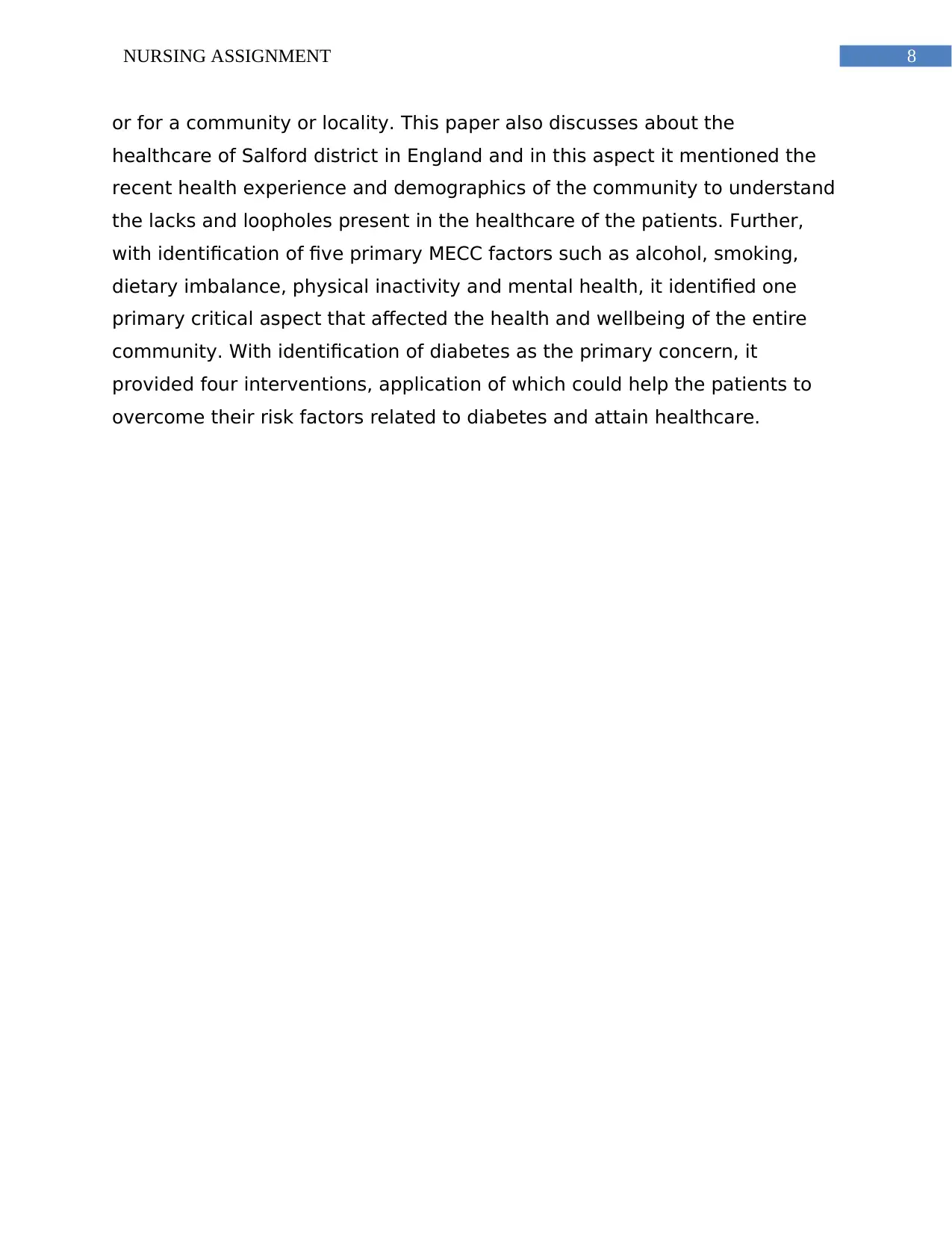
8NURSING ASSIGNMENT
or for a community or locality. This paper also discusses about the
healthcare of Salford district in England and in this aspect it mentioned the
recent health experience and demographics of the community to understand
the lacks and loopholes present in the healthcare of the patients. Further,
with identification of five primary MECC factors such as alcohol, smoking,
dietary imbalance, physical inactivity and mental health, it identified one
primary critical aspect that affected the health and wellbeing of the entire
community. With identification of diabetes as the primary concern, it
provided four interventions, application of which could help the patients to
overcome their risk factors related to diabetes and attain healthcare.
or for a community or locality. This paper also discusses about the
healthcare of Salford district in England and in this aspect it mentioned the
recent health experience and demographics of the community to understand
the lacks and loopholes present in the healthcare of the patients. Further,
with identification of five primary MECC factors such as alcohol, smoking,
dietary imbalance, physical inactivity and mental health, it identified one
primary critical aspect that affected the health and wellbeing of the entire
community. With identification of diabetes as the primary concern, it
provided four interventions, application of which could help the patients to
overcome their risk factors related to diabetes and attain healthcare.
⊘ This is a preview!⊘
Do you want full access?
Subscribe today to unlock all pages.

Trusted by 1+ million students worldwide
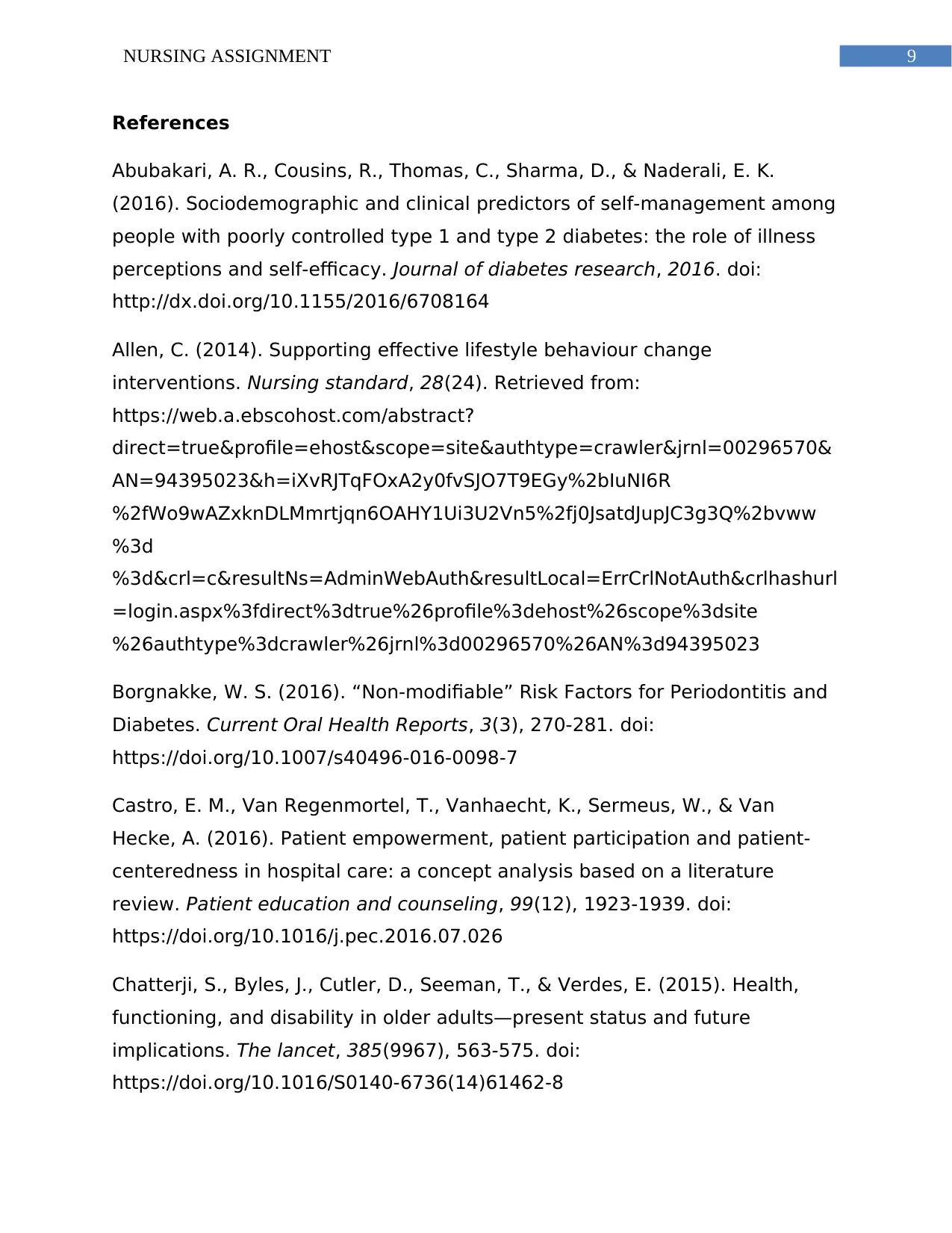
9NURSING ASSIGNMENT
References
Abubakari, A. R., Cousins, R., Thomas, C., Sharma, D., & Naderali, E. K.
(2016). Sociodemographic and clinical predictors of self-management among
people with poorly controlled type 1 and type 2 diabetes: the role of illness
perceptions and self-efficacy. Journal of diabetes research, 2016. doi:
http://dx.doi.org/10.1155/2016/6708164
Allen, C. (2014). Supporting effective lifestyle behaviour change
interventions. Nursing standard, 28(24). Retrieved from:
https://web.a.ebscohost.com/abstract?
direct=true&profile=ehost&scope=site&authtype=crawler&jrnl=00296570&
AN=94395023&h=iXvRJTqFOxA2y0fvSJO7T9EGy%2bIuNI6R
%2fWo9wAZxknDLMmrtjqn6OAHY1Ui3U2Vn5%2fj0JsatdJupJC3g3Q%2bvww
%3d
%3d&crl=c&resultNs=AdminWebAuth&resultLocal=ErrCrlNotAuth&crlhashurl
=login.aspx%3fdirect%3dtrue%26profile%3dehost%26scope%3dsite
%26authtype%3dcrawler%26jrnl%3d00296570%26AN%3d94395023
Borgnakke, W. S. (2016). “Non-modifiable” Risk Factors for Periodontitis and
Diabetes. Current Oral Health Reports, 3(3), 270-281. doi:
https://doi.org/10.1007/s40496-016-0098-7
Castro, E. M., Van Regenmortel, T., Vanhaecht, K., Sermeus, W., & Van
Hecke, A. (2016). Patient empowerment, patient participation and patient-
centeredness in hospital care: a concept analysis based on a literature
review. Patient education and counseling, 99(12), 1923-1939. doi:
https://doi.org/10.1016/j.pec.2016.07.026
Chatterji, S., Byles, J., Cutler, D., Seeman, T., & Verdes, E. (2015). Health,
functioning, and disability in older adults—present status and future
implications. The lancet, 385(9967), 563-575. doi:
https://doi.org/10.1016/S0140-6736(14)61462-8
References
Abubakari, A. R., Cousins, R., Thomas, C., Sharma, D., & Naderali, E. K.
(2016). Sociodemographic and clinical predictors of self-management among
people with poorly controlled type 1 and type 2 diabetes: the role of illness
perceptions and self-efficacy. Journal of diabetes research, 2016. doi:
http://dx.doi.org/10.1155/2016/6708164
Allen, C. (2014). Supporting effective lifestyle behaviour change
interventions. Nursing standard, 28(24). Retrieved from:
https://web.a.ebscohost.com/abstract?
direct=true&profile=ehost&scope=site&authtype=crawler&jrnl=00296570&
AN=94395023&h=iXvRJTqFOxA2y0fvSJO7T9EGy%2bIuNI6R
%2fWo9wAZxknDLMmrtjqn6OAHY1Ui3U2Vn5%2fj0JsatdJupJC3g3Q%2bvww
%3d
%3d&crl=c&resultNs=AdminWebAuth&resultLocal=ErrCrlNotAuth&crlhashurl
=login.aspx%3fdirect%3dtrue%26profile%3dehost%26scope%3dsite
%26authtype%3dcrawler%26jrnl%3d00296570%26AN%3d94395023
Borgnakke, W. S. (2016). “Non-modifiable” Risk Factors for Periodontitis and
Diabetes. Current Oral Health Reports, 3(3), 270-281. doi:
https://doi.org/10.1007/s40496-016-0098-7
Castro, E. M., Van Regenmortel, T., Vanhaecht, K., Sermeus, W., & Van
Hecke, A. (2016). Patient empowerment, patient participation and patient-
centeredness in hospital care: a concept analysis based on a literature
review. Patient education and counseling, 99(12), 1923-1939. doi:
https://doi.org/10.1016/j.pec.2016.07.026
Chatterji, S., Byles, J., Cutler, D., Seeman, T., & Verdes, E. (2015). Health,
functioning, and disability in older adults—present status and future
implications. The lancet, 385(9967), 563-575. doi:
https://doi.org/10.1016/S0140-6736(14)61462-8
Paraphrase This Document
Need a fresh take? Get an instant paraphrase of this document with our AI Paraphraser
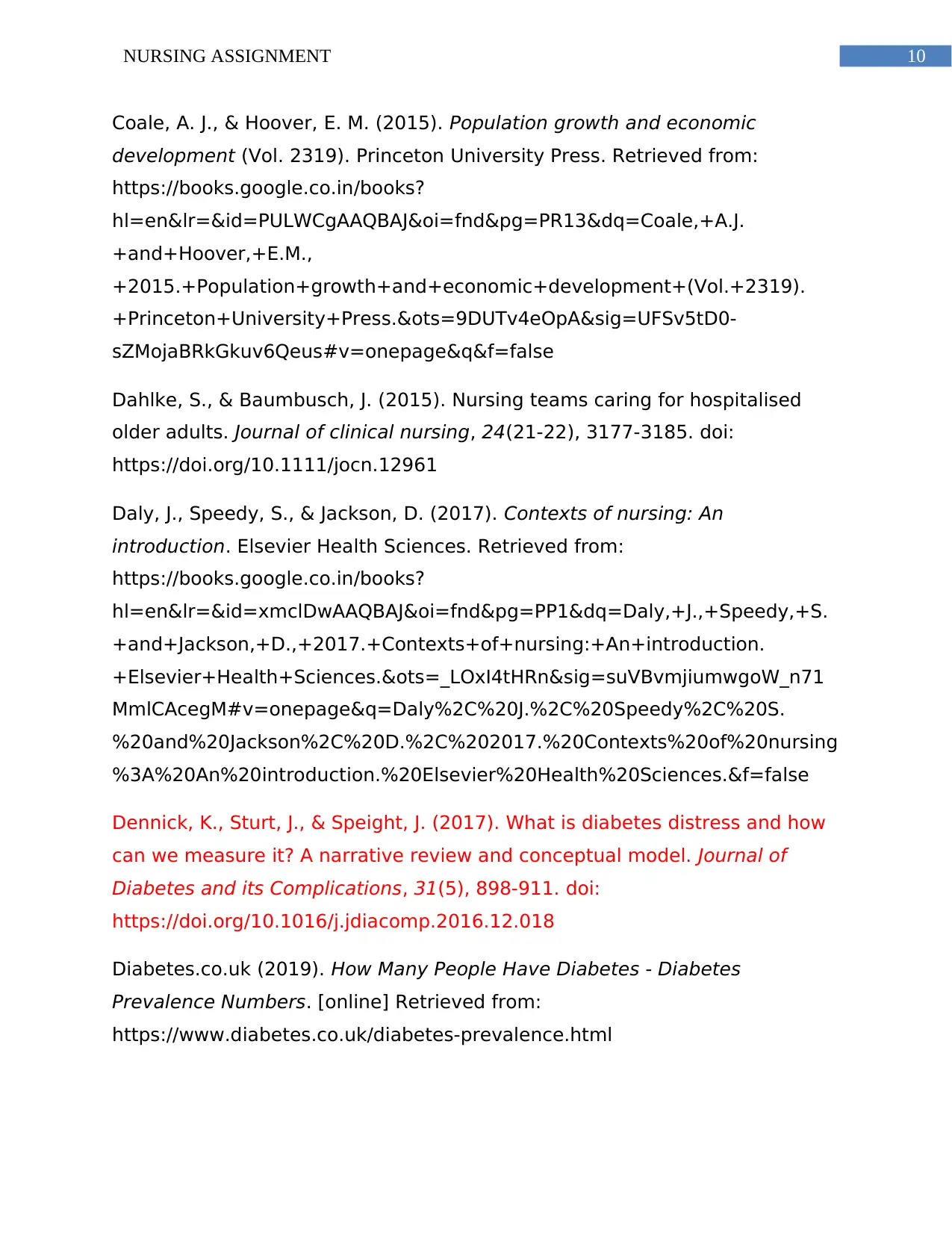
10NURSING ASSIGNMENT
Coale, A. J., & Hoover, E. M. (2015). Population growth and economic
development (Vol. 2319). Princeton University Press. Retrieved from:
https://books.google.co.in/books?
hl=en&lr=&id=PULWCgAAQBAJ&oi=fnd&pg=PR13&dq=Coale,+A.J.
+and+Hoover,+E.M.,
+2015.+Population+growth+and+economic+development+(Vol.+2319).
+Princeton+University+Press.&ots=9DUTv4eOpA&sig=UFSv5tD0-
sZMojaBRkGkuv6Qeus#v=onepage&q&f=false
Dahlke, S., & Baumbusch, J. (2015). Nursing teams caring for hospitalised
older adults. Journal of clinical nursing, 24(21-22), 3177-3185. doi:
https://doi.org/10.1111/jocn.12961
Daly, J., Speedy, S., & Jackson, D. (2017). Contexts of nursing: An
introduction. Elsevier Health Sciences. Retrieved from:
https://books.google.co.in/books?
hl=en&lr=&id=xmclDwAAQBAJ&oi=fnd&pg=PP1&dq=Daly,+J.,+Speedy,+S.
+and+Jackson,+D.,+2017.+Contexts+of+nursing:+An+introduction.
+Elsevier+Health+Sciences.&ots=_LOxI4tHRn&sig=suVBvmjiumwgoW_n71
MmlCAcegM#v=onepage&q=Daly%2C%20J.%2C%20Speedy%2C%20S.
%20and%20Jackson%2C%20D.%2C%202017.%20Contexts%20of%20nursing
%3A%20An%20introduction.%20Elsevier%20Health%20Sciences.&f=false
Dennick, K., Sturt, J., & Speight, J. (2017). What is diabetes distress and how
can we measure it? A narrative review and conceptual model. Journal of
Diabetes and its Complications, 31(5), 898-911. doi:
https://doi.org/10.1016/j.jdiacomp.2016.12.018
Diabetes.co.uk (2019). How Many People Have Diabetes - Diabetes
Prevalence Numbers. [online] Retrieved from:
https://www.diabetes.co.uk/diabetes-prevalence.html
Coale, A. J., & Hoover, E. M. (2015). Population growth and economic
development (Vol. 2319). Princeton University Press. Retrieved from:
https://books.google.co.in/books?
hl=en&lr=&id=PULWCgAAQBAJ&oi=fnd&pg=PR13&dq=Coale,+A.J.
+and+Hoover,+E.M.,
+2015.+Population+growth+and+economic+development+(Vol.+2319).
+Princeton+University+Press.&ots=9DUTv4eOpA&sig=UFSv5tD0-
sZMojaBRkGkuv6Qeus#v=onepage&q&f=false
Dahlke, S., & Baumbusch, J. (2015). Nursing teams caring for hospitalised
older adults. Journal of clinical nursing, 24(21-22), 3177-3185. doi:
https://doi.org/10.1111/jocn.12961
Daly, J., Speedy, S., & Jackson, D. (2017). Contexts of nursing: An
introduction. Elsevier Health Sciences. Retrieved from:
https://books.google.co.in/books?
hl=en&lr=&id=xmclDwAAQBAJ&oi=fnd&pg=PP1&dq=Daly,+J.,+Speedy,+S.
+and+Jackson,+D.,+2017.+Contexts+of+nursing:+An+introduction.
+Elsevier+Health+Sciences.&ots=_LOxI4tHRn&sig=suVBvmjiumwgoW_n71
MmlCAcegM#v=onepage&q=Daly%2C%20J.%2C%20Speedy%2C%20S.
%20and%20Jackson%2C%20D.%2C%202017.%20Contexts%20of%20nursing
%3A%20An%20introduction.%20Elsevier%20Health%20Sciences.&f=false
Dennick, K., Sturt, J., & Speight, J. (2017). What is diabetes distress and how
can we measure it? A narrative review and conceptual model. Journal of
Diabetes and its Complications, 31(5), 898-911. doi:
https://doi.org/10.1016/j.jdiacomp.2016.12.018
Diabetes.co.uk (2019). How Many People Have Diabetes - Diabetes
Prevalence Numbers. [online] Retrieved from:
https://www.diabetes.co.uk/diabetes-prevalence.html
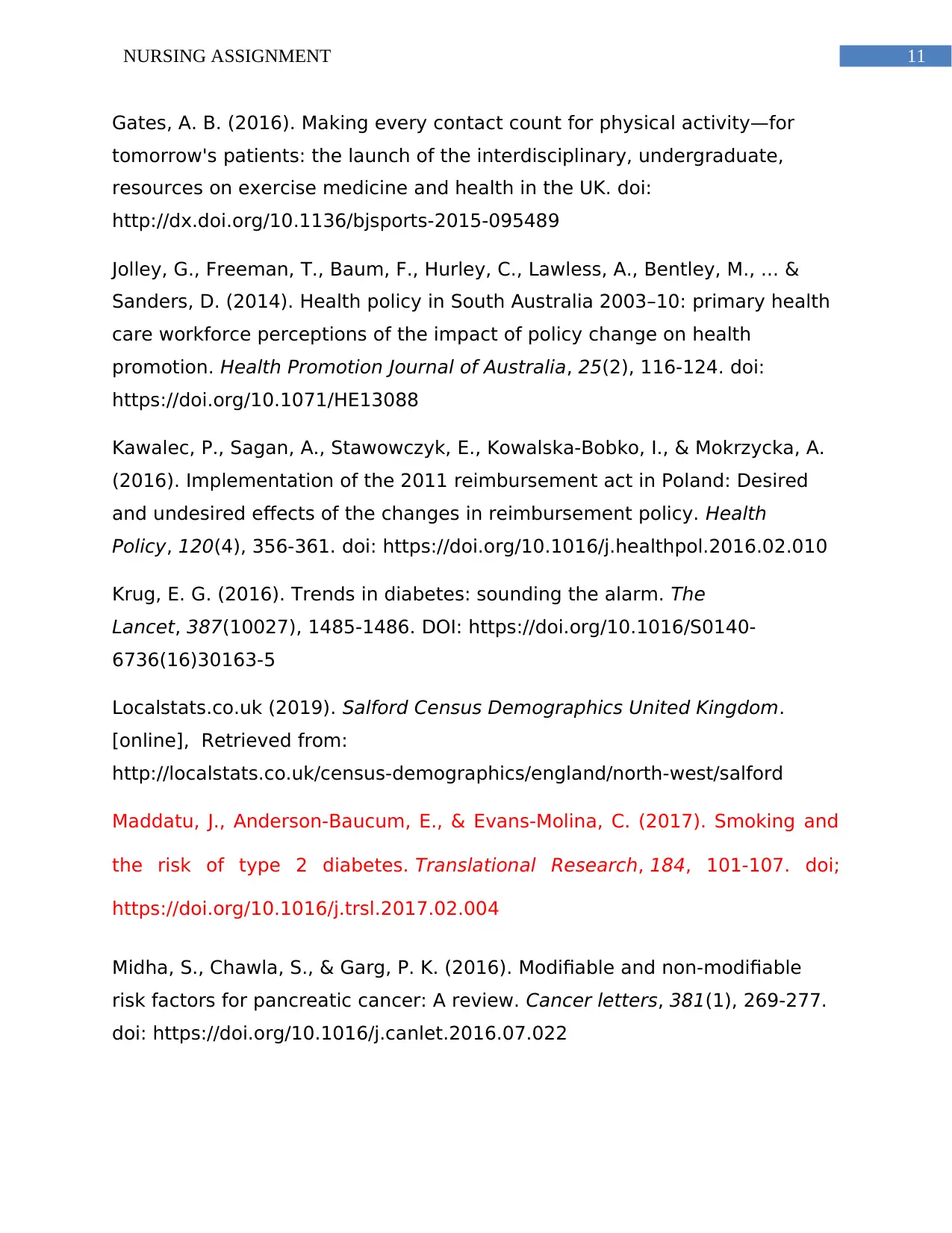
11NURSING ASSIGNMENT
Gates, A. B. (2016). Making every contact count for physical activity—for
tomorrow's patients: the launch of the interdisciplinary, undergraduate,
resources on exercise medicine and health in the UK. doi:
http://dx.doi.org/10.1136/bjsports-2015-095489
Jolley, G., Freeman, T., Baum, F., Hurley, C., Lawless, A., Bentley, M., ... &
Sanders, D. (2014). Health policy in South Australia 2003–10: primary health
care workforce perceptions of the impact of policy change on health
promotion. Health Promotion Journal of Australia, 25(2), 116-124. doi:
https://doi.org/10.1071/HE13088
Kawalec, P., Sagan, A., Stawowczyk, E., Kowalska-Bobko, I., & Mokrzycka, A.
(2016). Implementation of the 2011 reimbursement act in Poland: Desired
and undesired effects of the changes in reimbursement policy. Health
Policy, 120(4), 356-361. doi: https://doi.org/10.1016/j.healthpol.2016.02.010
Krug, E. G. (2016). Trends in diabetes: sounding the alarm. The
Lancet, 387(10027), 1485-1486. DOI: https://doi.org/10.1016/S0140-
6736(16)30163-5
Localstats.co.uk (2019). Salford Census Demographics United Kingdom.
[online], Retrieved from:
http://localstats.co.uk/census-demographics/england/north-west/salford
Maddatu, J., Anderson-Baucum, E., & Evans-Molina, C. (2017). Smoking and
the risk of type 2 diabetes. Translational Research, 184, 101-107. doi;
https://doi.org/10.1016/j.trsl.2017.02.004
Midha, S., Chawla, S., & Garg, P. K. (2016). Modifiable and non-modifiable
risk factors for pancreatic cancer: A review. Cancer letters, 381(1), 269-277.
doi: https://doi.org/10.1016/j.canlet.2016.07.022
Gates, A. B. (2016). Making every contact count for physical activity—for
tomorrow's patients: the launch of the interdisciplinary, undergraduate,
resources on exercise medicine and health in the UK. doi:
http://dx.doi.org/10.1136/bjsports-2015-095489
Jolley, G., Freeman, T., Baum, F., Hurley, C., Lawless, A., Bentley, M., ... &
Sanders, D. (2014). Health policy in South Australia 2003–10: primary health
care workforce perceptions of the impact of policy change on health
promotion. Health Promotion Journal of Australia, 25(2), 116-124. doi:
https://doi.org/10.1071/HE13088
Kawalec, P., Sagan, A., Stawowczyk, E., Kowalska-Bobko, I., & Mokrzycka, A.
(2016). Implementation of the 2011 reimbursement act in Poland: Desired
and undesired effects of the changes in reimbursement policy. Health
Policy, 120(4), 356-361. doi: https://doi.org/10.1016/j.healthpol.2016.02.010
Krug, E. G. (2016). Trends in diabetes: sounding the alarm. The
Lancet, 387(10027), 1485-1486. DOI: https://doi.org/10.1016/S0140-
6736(16)30163-5
Localstats.co.uk (2019). Salford Census Demographics United Kingdom.
[online], Retrieved from:
http://localstats.co.uk/census-demographics/england/north-west/salford
Maddatu, J., Anderson-Baucum, E., & Evans-Molina, C. (2017). Smoking and
the risk of type 2 diabetes. Translational Research, 184, 101-107. doi;
https://doi.org/10.1016/j.trsl.2017.02.004
Midha, S., Chawla, S., & Garg, P. K. (2016). Modifiable and non-modifiable
risk factors for pancreatic cancer: A review. Cancer letters, 381(1), 269-277.
doi: https://doi.org/10.1016/j.canlet.2016.07.022
⊘ This is a preview!⊘
Do you want full access?
Subscribe today to unlock all pages.

Trusted by 1+ million students worldwide
1 out of 15
Related Documents
Your All-in-One AI-Powered Toolkit for Academic Success.
+13062052269
info@desklib.com
Available 24*7 on WhatsApp / Email
![[object Object]](/_next/static/media/star-bottom.7253800d.svg)
Unlock your academic potential
Copyright © 2020–2025 A2Z Services. All Rights Reserved. Developed and managed by ZUCOL.




